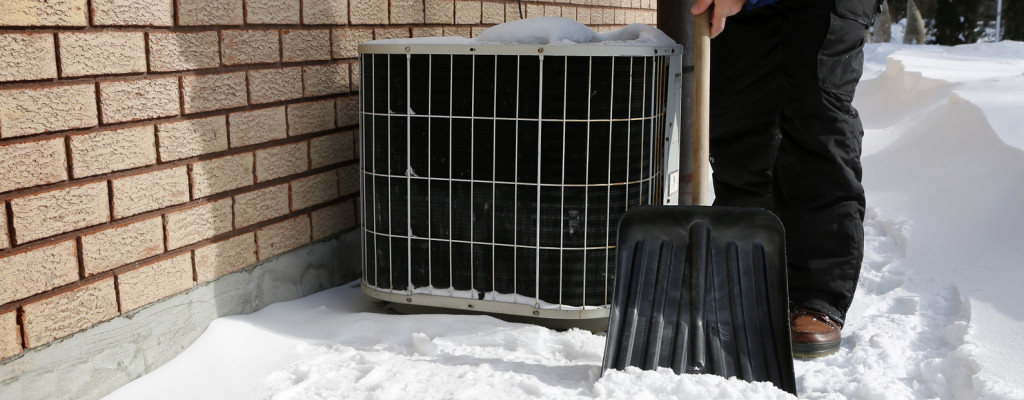Before you spend those chilly winter days bundled up and staying warm inside, you need to get your heating and cooling system ready for the colder weather. You’ll be relying on your furnace to keep inside temperatures cozy for the next few months, and even though your air conditioner hibernates for the winter, it’ll need to be protected from the harsh elements, too.
Winterizing your home and your HVAC system now means that you’ll be able to rely on it all winter long without worry. A professionally inspected and tuned-up furnace will operate safely, keep your home warm, and will help you lower those high energy bills during the winter. Follow these smart tips to get your home ready for the season.
Prepare your home for cold weather
Your home is the first place to start in the winterization process, before even looking at your HVAC system. By checking the following items, you’ll save on energy costs, and you’ll be able to trust that your heating system is running as well as it can.
Check for drafts. If you can feel cold through a window or you test it with a lighter and see the flame flicker, you’ll need to reseal it. Poorly insulated windows make your furnace work harder to keep your home warm, decreasing the unit’s longevity and causing your energy costs to increase. If you feel a draft, install weather stripping or apply caulk to the affected area.
Add a programmable thermostat. When you’re not at home, your heat doesn’t need to be running as much. But, when you return, you want a warm house to come home to. With a standard thermostat, you have to turn it set the temperature lower before you leave to save money and turn it back up again when you come back. A programmable thermostat does this for you, and smart thermostats can even learn your home/away patterns to keep you and your heating budget even more comfortable!
Inspect your home’s insulation. Insulation helps keep the warm air in and the cold air out during the winter, and vice-versa in the summer. Start the inspection process by reviewing this outstanding article on Energy.gov and then comparing your home’s insulation to the recommended levels. Add insulation everywhere your home falls short – it may cost you a little now, but it’ll save you a lot over time.
Winterize your air conditioner
The arrival of winter means that you won’t be needing to run your air conditioner. In all likelihood, you won’t be turning your AC on again until spring. This doesn’t mean you can stop thinking about the cooling part of your HVAC system until then, though. Your air conditioning unit is outside, exposed to the elements, and needs to be winterized, too. Following these steps will protect it from snow, ice, rust, and worse.
Remove debris. Cleaning up leaves, twigs and other debris in and around your air conditioning unit will prevent it from damaging your unit.
Turn off the power to the unit. If a fluke warm day happens during winter, you don’t want your air conditioner to turn on unexpectedly. Make sure that no electricity can flow to the system. This prevents the lines from freezing if that unseasonably warm day turns into a cold night.
Add insulating foam around your pipes. Insulating your AC lines will help keep them from freezing. Just like a can of soda will burst in your freezer, allowing the fluids to freeze in your system’s lines can cause severe damage.
Cover the outside unit. Get a waterproof cover to prevent snow and other debris from falling into your AC unit. Allowing things to sit inside your outdoor unit throughout the winter could cause damage to internal parts.
Check the unit often. After snowstorms, or even just occasionally throughout winter, inspect your air conditioning system inside and outside for damage or debris. Regular inspections mean that you’ll be able to turn it back on worry-free when spring comes.
Winterize your furnace
Your furnace will probably be running all winter long, and you want it to run safely and efficiently. Follow these steps to make sure it handles those cold nights.
Clean up around your furnace. Your furnace will be a source of considerable heat during the winter, and you’ll want to make sure the area around the unit is clear of any flammable materials. Don’t keep cardboard boxes, household cleaning products, cans of paint, etc. near it. Failure to remove these items could cause a fire and damage much more than just your furnace.
Check your furnace’s exhaust. When clearing the furnace area of any debris, also make sure its exhaust vents are clear. If you discover an obstruction, call us, and we’ll come out, clear the blockage and ensure your furnace is exhausting waste gas properly.
Test your carbon monoxide detector (or install one). Keep your family safe by making sure you have a carbon monoxide (CO) detector and that it’s working as it should. Carbon monoxide gas is an invisible killer – it’s odorless and colorless, so it is essential to have a detector in place to prevent a potential tragedy, should your furnace malfunction and allow CO gas to accumulate in your home.
Have your furnace professionally serviced. With months of hard work ahead of it, your furnace needs to be in tip-top shape. We’ll check the blower belt, oil the blower motor, and inspect all mechanical aspects of your heating system. With temperatures already dropping, our schedule is filling up fast, so call us today to have your system serviced before it really gets cold outside!
Replace your filter. To make sure the air coming into your home is as clean as it can be – and that your furnace doesn’t pull in any debris – replace your filter regularly. It’s also handy to have a few spare filters on hand so you can easily keep a fresh filter in your system throughout the season.
A little preparation in the fall will go a long way in the winter. Following the steps above to winterize your home will make sure that your AC stays protected and that your furnace keeps you warm all winter long. If you need help with preparing your home for winter or have questions in general, give us a call – we’re happy to help! That’s how neighbors should treat neighbors!™


Comments are closed